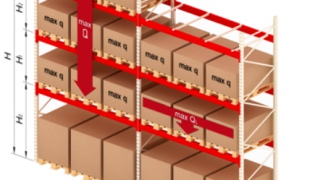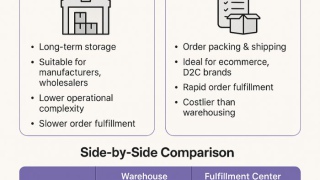In the swiftly evolving landscape of logistics and supply chain management, warehouses are no longer mere storage facilities but dynamic hubs crucial to a company's success. The pressure to optimize operations, reduce costs, and enhance customer satisfaction is immense. This is where Artificial Intelligence (AI) steps in, revolutionizing warehouse management through its unparalleled ability to analyse vast datasets and predict future trends. For magazijnservice.nl, a leader in warehouse solutions, understanding and adopting these AI-driven strategies is not just an advantage, it's a necessity.

The Evolution of Warehouse Management: From Reactive to Predictive
Historically, warehouse management has been largely reactive. Decisions were made based on immediate needs, often leading to inefficiencies such as stockouts, overstocking, and suboptimal labor allocation. Manual processes, while foundational, simply cannot keep pace with the complexities of modern supply chains, characterized by fluctuating demand, shorter lead times, and global distribution networks.
The advent of predictive analytics, powered by AI, marks a paradigm shift. Instead of reacting to events, warehouses can now anticipate them. This proactive approach transforms every aspect of operations, from inventory control to personnel management, leading to significant gains in efficiency, cost reduction, and customer satisfaction.
AI's Core Contribution: Unlocking Insights from Data
At the heart of AI's power in warehouse management lies its capacity to process and derive insights from colossal amounts of data – far beyond human capabilities. Modern warehouses generate data from countless sources: inventory tracking systems, RFID tags, IoT sensors on equipment, order management systems, weather forecasts, and even social media trends. AI algorithms can sift through this data, identify patterns, and build models that predict future outcomes with remarkable accuracy.
Key Areas Where AI and Predictive Analytics Are Transforming Warehousing:
-
Demand Forecasting and Inventory Optimization: This is perhaps one of the most impactful applications of AI. Traditional forecasting methods often struggle with volatility and unexpected market shifts. AI, utilizing machine learning algorithms, can analyze historical sales data, promotional calendars, seasonal trends, economic indicators, and even external factors like news events or competitor actions to generate highly accurate demand forecasts.
Reduced Stockouts: By accurately predicting demand, warehouses can ensure they have the right products in stock at the right time, minimizing lost sales dueibilities to stockouts.
Minimizing Overstocking: Conversely, AI helps prevent overstocking, which ties up capital, occupies valuable warehouse space, and increases the risk of obsolescence.
Dynamic Reorder Points: AI can continuously adjust reorder points and quantities based on real-time data and predicted demand, leading to more agile inventory management.
-
Optimized Space Utilization: Warehouse space is a valuable asset. AI can analyze product dimensions, movement patterns, and demand forecasts to recommend the most efficient storage locations.
Slotting Optimization: AI algorithms can determine the optimal placement of SKUs (Stock Keeping Units) based on their picking frequency, co-occurrence with other items, and accessibility, reducing travel time for pickers.
Dynamic Space Allocation: As inventory levels fluctuate, AI can suggest adjustments to storage layouts to maximize available space, even identifying underutilized areas.
-
Predictive Maintenance of Equipment: Downtime due to equipment failure can severely disrupt warehouse operations. AI, combined with IoT sensors on machinery like forklifts, conveyors, and automated guided vehicles (AGVs), can predict potential equipment failures before they occur.
Reduced Unplanned Downtime: Sensors collect data on vibrations, temperature, motor performance, and other parameters. AI analyzes this data to identify anomalies indicative of impending issues, allowing for proactive maintenance scheduling.
Extended Equipment Lifespan: Regular, condition-based maintenance, rather than time-based maintenance, ensures equipment is serviced only when needed, extending its operational life.
Optimized Maintenance Costs: By preventing major breakdowns, companies can avoid costly emergency repairs and reduce overall maintenance expenditure.
-
Workforce Management and Labor Optimization: Labor costs represent a significant portion of warehouse operating expenses. AI can optimize staffing levels and task assignments.
Predictive Staffing Needs: Based on predicted order volumes and operational complexity, AI can accurately forecast labor requirements, ensuring sufficient staff without over-hiring.
Dynamic Task Assignment: AI can assign tasks to employees based on their skills, location within the warehouse, and the urgency of the task, minimizing idle time and maximizing productivity.
Route Optimization for Pickers: AI algorithms can calculate the most efficient picking routes, reducing travel time and improving picking accuracy.
-
Optimized Picking and Packing Processes: Picking and packing are often the most labor-intensive parts of warehouse operations. AI can significantly improve their efficiency.
Batch Picking and Zone Picking Optimization: AI can group orders effectively for batch picking or optimize assignments for zone picking, reducing redundant travel.
Robotics Integration: AI is the brains behind warehouse robotics, including picking robots and automated storage and retrieval systems (AS/RS). These systems leverage AI for navigation, object recognition, and intelligent task execution, drastically increasing throughput and accuracy.
Enhanced Security and Loss Prevention: AI-powered surveillance systems can monitor warehouse activity 24/7, identifying suspicious behavior or potential security breaches.
-
Anomaly Detection: AI can detect unusual patterns in inventory movement, access logs, or video feeds that might indicate theft or unauthorized access.
-
Improved Compliance: AI can help ensure adherence to safety regulations and operational procedures by monitoring worker behavior and environmental conditions.
-
Supplier Performance Evaluation and Risk Management: Beyond the warehouse walls, AI can analyze data from suppliers to predict potential delays or quality issues.
Proactive Risk Mitigation: By identifying at-risk suppliers or potential bottlenecks in the supply chain, warehouses can implement contingency plans.
Improved Supplier Relationships: Objective, data-driven insights allow for more effective communication and collaboration with suppliers.
Implementing AI in Your Warehouse: A Practical Approach for magazijnservice.nl Clients
For businesses partnering with magazijnservice.nl, integrating AI into existing warehouse operations doesn't have to be an overnight revolution. It's often a phased approach, focusing on areas with the highest potential impact.
-
Data is King: The first step is ensuring you have clean, accessible, and comprehensive data. Without robust data collection, AI models cannot learn effectively.
-
Start Small, Scale Up: Begin with a pilot project in a specific area, such as demand forecasting for a particular product category or predictive maintenance for a critical piece of equipment.
-
Choose the Right Tools and Partners: Select AI solutions that integrate seamlessly with your existing Warehouse Management System (WMS) and Enterprise Resource Planning (ERP) systems. Partner with experts like magazijnservice.nl who understand both warehouse operations and AI capabilities.
-
Embrace Continuous Improvement: AI models are not static; they require continuous training and refinement as new data becomes available and business needs evolve.
-
Focus on Training and Adoption: Successful AI implementation requires buy-in from employees. Training programs should emphasize how AI tools augment human capabilities, making jobs easier and more efficient, rather than replacing them.
The Future of Warehousing is Intelligent
The integration of AI and predictive analytics is not just a trend; it's the future of warehouse management. For magazijnservice.nl and its clients, embracing these technologies means moving beyond traditional reactive approaches to a proactive, data-driven operational model. This shift will lead to unprecedented levels of efficiency, cost savings, and ultimately, a stronger competitive edge in an increasingly demanding market. By leveraging the power of AI, warehouses can transform from cost centers into strategic assets, capable of adapting to change, anticipating demand, and consistently exceeding customer expectations. The intelligent warehouse is no longer a futuristic concept; it's a present-day reality, ripe for exploration and implementation.
_0x70_d59.png)



